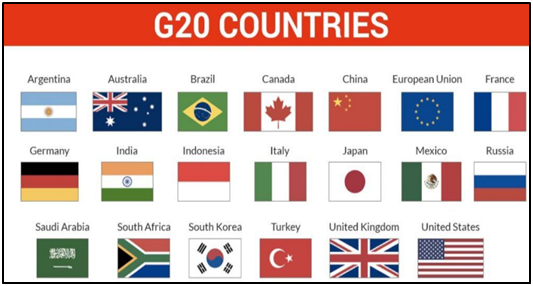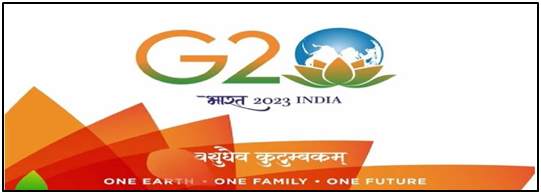In News:
- The Prime Minister, Shri Narendra Modi unveiled the logo, theme and website of India’s G-20 Presidency via video conferencing.
- The G20 Leaders’ Summit at the level of Heads of State/Government is scheduled to be held on September 9 and 10, 2023 in New Delhi.
What’s in Today’s Article:
- G-20 – About, working, significance
- News Summary
In Focus: G-20

- G-20 was a group of finance ministers and central bank governors from 19 individual countries and European Union. It was established in 1999.
- G20 was elevated to a forum of Heads of State/Government in 2008 to effectively respond to the global financial crisis of 2008.
- G-20 is a forum, not a legislative body. Its agreements and decisions have no legal impact, but they do influence countries' policies and global cooperation.
Working of G20
- The G20 has no permanent secretariat. The agenda and work are coordinated by representatives of the G20 countries, known as ‘Sherpas’.
- For India, ex-NITI Aayog CEO Amitabh Kant is the current G20 Sherpa.
- The presidency of the G20 rotates every year among members, and the country holding the presidency, together with the previous and next presidency-holder, forms the ‘Troika’.
- Troika ensures continuity of the G20 agenda.
- During India’s presidency, India, Indonesia and Brazil will form the troika.
Significance of G20
- Carries significant weight
- G20 members represent around 85% of global GDP, over 75% of global trade, and two-thirds of the world’s population.
- G20 members contribute 79% of the world carbon emissions and hence this platform assumes significance in shaping the discussion on climate change.
- Promotes Multilateralism
- Since 2011, the G20 summit has been held annually, under a rotating presidency.
- The practice of rotating the chair gives all the members a chance to shape the global agenda.
- A number of overarching themes
- Initially, the G20 focused on broad macroeconomic policy, but has since expanded its ambit to include trade, sustainable development, energy, environment, climate change, anti-corruption etc.
- Eg., 2021 summit decided to stop funding coal-fired power plants in poor countries by the end of 2021.
- It also committed to seek carbon neutrality “by or around mid-century”.
- 2021 summit endorsed the Two-Pillar Solution to Address the Tax Challenges Arising from the Digitalisation of the Economy.
- United Fight against COVID-19 Pandemic
- In March 2020, G20 leaders pledged to inject $5 trillion into the global economy to reduce the economic impact of the coronavirus pandemic.
- In addition to this, they also agreed to contribute to WHO’s COVID-19 Solidarity Response Fund on voluntary basis.
News Summary
- PM Modi unveiled the logo, theme and website of India’s G20 presidency.
- India will assume the presidency of the powerful G20 grouping from the current chair, Indonesia, on December 1, and hold the post for a year.
Key Highlights:

- The logo — Earth juxtaposed with the lotus,
- Theme — “Vasudhaiva Kutumba-kam” or “One Earth One Family One Future”
- The logo reflects India’s idea of VasudhaivaKutumbakam (the whole earth is a family), because of which India has always believed in global harmony.
Key highlights of the speech delivered by PM Modi
- India’s G20 presidency is coming at a time of crisis and chaos in the world.
- The world is going through the after-effects of a disruptive once-in-a-century pandemic, conflicts and a lot of economic uncertainty.
- The symbol of the lotus in the G20 logo is a representation of hope in this time.
- Elaborating on the theme, PM Modi said India is working on the vision of bringing the whole world together for a common objective, for a better future.
- It will be India’s endeavour that there should not be any first world or third world, but “only one world”.
- India, with its mantra of ‘One Sun, One World, One Grid’, has called for a renewable energy revolution in the world.
- India took up a campaign of ‘One World, One Health’ to strengthen global health.
- Now, in the G20 also, India’s mantra is One Earth, One Family, One Future.











